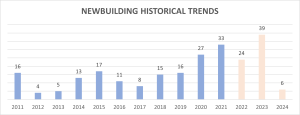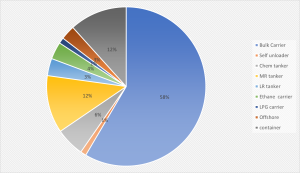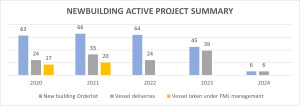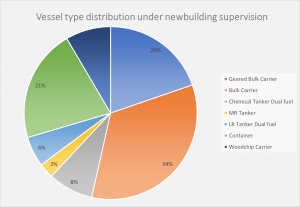FLEET’s Newbuilding department was founded on the belief that proper supervision by an experienced team can have an immense effect on the quality and lifecycle cost of the vessel being built. Our job is to confirm that the vessel conforms to the contracted specification of the owner, meets industry rules and regulations, meets enhanced safety and operational standards and that it is fit to operate without requiring any major retrofits after delivery.
Our team offers different tiers of service such as A) specification review, plan approval, and supervision of the new build, B) plan approval based on contracted specifications and supervision of the new build, or C) only supervision of the new build or at times D) only managing the plan approval process.
Since the inception of our Newbuilding department in 2010 more than 180 ships have been delivered. Graph 1.1 captures our growth over the past decade and projects our growth pipeline of newbuilding projects.

Over the years, FLEET’s Newbuilding department has delivered most types of vessels. Graph 1.2 gives an overview of the different types of vessels we have delivered from more than 40 yards across China, South Korea, Japan, and Vietnam.

Here are some of the notable project’s we have delivered:
- A 68,000 DWT self-unloader designed especially for aggregates
- A very large dual fuel Ethane carrier
- A 95,000 DWT Bulk Carrier which at the time of delivery was the world’s first air lubrication system of this size
- An LPG carrier
With the entire shipping industry focused on the IMO’s ambitious goals and targets to reduce shipping’s carbon emissions, we saw an increase in the construction of dual-fuel ships and gas carriers – see Graph 1.3. We’re proud to say that in the past two years our team successfully delivered the world’s first six Ethane carriers with the capacity to burn Ethane and liquid fuel. We owe it to our team’s in-depth expertise as the reason we were able to secure an additional six dual-fuel DSS chemical tankers and four dual-fuel LR tankers this year.

Having built up a strong portfolio of experience and expertise in building different types of ships, our team continues to take on new orders that broaden our portfolio. Graph 1.4 provides a detailed view of our current newbuilding portfolio according to ship type.

Energy efficiency and operational safety are key considerations taken into every one of our projects. On the energy efficiency front, we have worked very closely with different energy-saving devices (ESDs) like twisted rudders, PDCF, nozzles, rudder bulbs, and heat recovery options, among others. Current trends include the use of LED lights with a minimum colour rendering index (CRI) above 80 (as is acceptable for human eyes) which has resulted in saving more than 85% in lighting power consumption. Air lubrication and promoting the use of permanent magnet shaft generators have also shown significant energy savings.
In fact, the installation of a permanent magnet type shaft generator on two self-unloader ships provided a maximum power output at and above Full–Ahead RPM of the engine while self-adjusting for any RPM fluctuations. At speeds below 64 RPM – even down to 26 RPM, the shaft generator operation continued with a proportionately reduced power output. This system reduced the use of fuel substantially for power generation at sea. Additionally, we also check and advise owners regarding the EEXI compliance of their new orders.
On the operational safety front, the team adopts input from the technical management and operations teams and can incorporate their recommendations at any point during the specification review, plan approval, and building stages – depending on when the team gets involved. One of our best practices is to lay out the different options available so that the teams have an opportunity to optimise solutions.
With a focus to constantly improve the quality and safety of newbuilds, we have taken several initiatives such as:
- Safety guards windlass/winch hydraulic motors
- Remote operating control for all mooring winches and with a protective cage for the operator
- A main switch for all power sockets has been added outside crew cabins (so the crew can now turn off the switch when leaving the cabin and avoid a potential fire incident during their absence)
- Fire detectors added to living spaces on hulls in compliance with SOLAS IIIC for fire detection
- Handrails added for safety upon entering the booby hatch and exiting tanks and cargo holds
- Mid rails have been made mandatory for all inclined ladders throughout the vessel
- Carlings added on the upper deck in way of corrugated bulkheads and full penetration welds done for tankers to avoid cracks during service
- Added removable coming around fuel sounding pipes to avoid spillage from sounding tapes
- Adjusting design of Crew Air conditioning to ensure systems have sufficient redundancy to always meet MLC 2006 requirements
- Application of IBTS along with evaporation systems on all new buildings
- Introduction of Intelligent system to monitor and transfer data and CCTV images ashore
The newbuilding of ships is an evolving discipline as new technologies and regulations are constantly being introduced. Our team is experienced to cope with the ever-evolving nature of newbuilding ships and is incredibly capable of supervising the most sophisticated vessels like LNG carriers, Ethane carriers, and ships equipped with a dual-fuel engine.
With so much focus in the industry on reducing the carbon emission of ships, we’ve observed a huge shift to gas as a fuel over the past year. To keep pace with the industry shift towards dual fuel, the newbuilding team has expanded our internal expertise to include dual-fuel knowledge and design. We are currently supervising six dual-fuel LNG chemical tankers and four dual-fuel LR tankers. These also include the plan approvals.
Due to travel restrictions stemming from the COVID-19 pandemic, our colleagues in China were well-placed to assist the technical management teams with supervision for docking, repairs, and retrofits in China. We brought together a dedicated team of about 10 superintendents, drawn from various fields of expertise, who have carried out 65 docking, retrofits, and repairs over the last two years. The team has also carried out 25 BWTS and 10 scrubber retrofits so far.
Going forward, continued efforts are being made to encourage dual qualification among our team members. In absence of physical visits, the team in Hong Kong monitors site inspections using video communication tools such as WeChat and WhatsApp. We also hold weekly and monthly video conferences to stay updated on performance and to enhance and build upon our existing safety culture among the team members. Staying connected and nurturing our colleagues and free communication has been of the utmost importance throughout the pandemic. This is to ensure our customers continued to receive the high level of service as before, and also to ensure that our colleagues and their families’ wellbeing are being taken into consideration.
By leveraging the possibilities of technology, we managed to strengthen our relationships and ways of working throughout the pandemic and as a result, we have been able to maintain business continuity. For that, we are very proud!
Source: https://www.fleetship.com/newbuilding-business/?fbclid=IwAR1L5CURhC8fLQcUl4JcMxB1oOjYU4kjk8jJn6vJmv-rUhYBXDc3MsLWB9s
